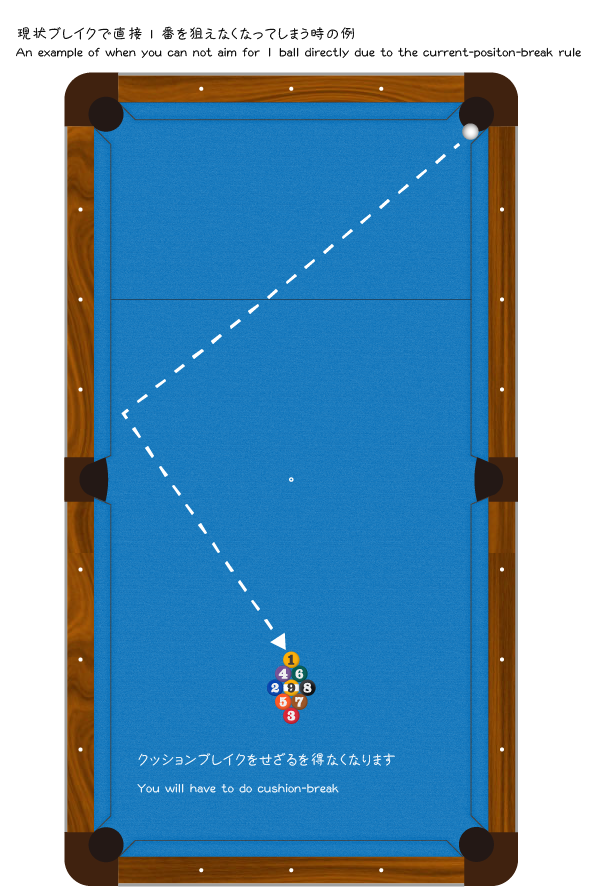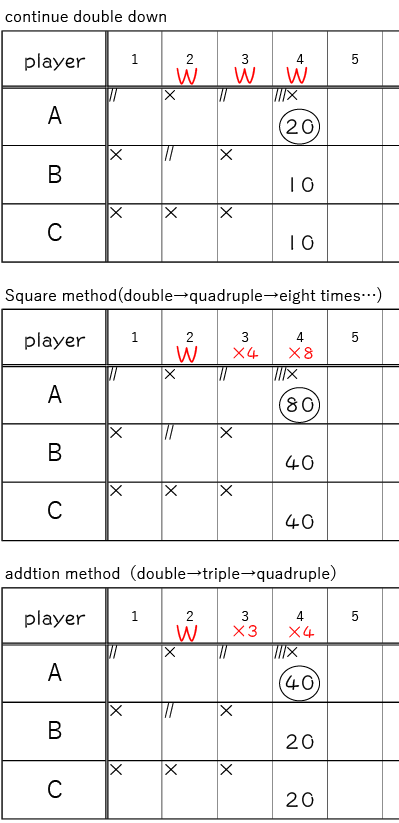オプション option
『ジャパン』にはルール設定となるオプションがあります。試合開始前に十分確認をして臨みましょう。

まずは9個でやるのか10個でやるのかを決めましょう。
First of all, let’s decide how many balls to play. 9 ball (JAPAN)? 10 ball(JAPAN)?
点球を決めましょう。
『3』『5』『7』『9』でやるのか、『5』『9』だけを点球にするのか等はプレイヤーが決められます。
点球を『3』『5』『7』『9』でやるのを『ジャパン』と呼び、『5』『9』でやるのを『ゴーキュー』または『ゴック』
『5』『7』『9』でやるのを『ゴナキュー』と言ったりします。
Decide the number of score balls.
In general, we set 『3』『5』『7』『9』as score balls in “JAPAN”.
But, if there are a lot of score balls, the points will move a lot, so we often play with a reduced number of score balls.
For example, we often play “JAPAN” with score balls of 『5』『9』.
大きく分けて2通りあります。
それは下記の通り。
1.フリーブレイク
2.現状ブレイク
フリーブレイクは通常のナインボール等と同じでブレイクを撞く人はキッチン内において好きなところに手球を置いてブレイクできます。
一方現状ブレイクは、最後の点球を入れた後、キッチン内で止まった手球の位置からそのままブレイクをすることを言います。(つまり、手球を好きな位置においてブレイクできるのは一番最初のゲームだけということです。)主に上級者向けのルールとなります。
ただ、現状ブレイクの場合、手球がポケットのギリギリのところに収まってしまって直接1番を狙えない場合があります。そうならないようにするのが上級者の技術ですが、そうなってしまってはブレイクが大変です。ブレイクなのにクッションから狙わなければならないという、とんでもない事態が発生してしまいます。
There are two main types.
It is as follows.
1. Free-position break
2. Current-position break
Free-position break is the same as normal nine-ball game. Those who break can place their cue ball anywhere in the kitchen.
On the other hand, the Current-position break is to break from the position of the cue ball that stopped in the kitchen after pocketing the last score ball. (In other words, you can break the cue ball in any position only in the very first game.) This rule is mainly for advanced players.
However, in the case of the Current-position break, the cue ball may fit in the pocket and you may not be able to aim directly at 1ball. It is an advanced technique to prevent this from happening, but if that happens, it will be difficult to break. You have to aim from the cushion, which is a ridiculous situation.

そこで、『1ボールプレイス』ルールがあります。現状からボール一つ分なら動かしてもいいというルールです。これならばボールがポケットに収まってもとりあえず直接ブレイクできるようになります。これならブレイクの後がぐちゃぐちゃにならなくていいと思います。
Therefore, there is a “one-ball-placement” rule. It is a rule that you can move within the area of one ball from current position. With this, even if the ball fits in the pocket, you will be able to break directly.
3ポイントルールでイリーガルブレイクとなった場合に選べるオプションは3種類
1.そのままプレイ続行
2.次のプレイヤーにチェンジ
3.マスワリをしても得点が倍にならない
There are 3 options to choose from if you get an illegal break with the 3-point rule
1. Continue playing (as balls are)
2. Change to the next player
3. You can continue to play. but the score does not double even if you run out.
ブレイクインした点球を得点(仮点に加算)とするかしないかを決めましょう。
例えば『2』と『5』がブレイクでポケットした場合『5』は順番通りとは言えませんので、フットスポットに戻します。
その時にポケットした『5』を得点とするかどうかです。せっかくブレイクで入ったのだから得点として有効という議論もあれば、説フラックが主流の現在においてブレイクで点球が入りやすくすることも可能ではあるので、それを無効とすべきという議論もあろうかと思います。
中間点をとってフットコーナーを無効にするというのもいいのではないでしょうか。
ちなみにですが、『1』『2』『3』がブレイクでポケットした場合には順番通りにポケットしたものとして、『3』はいずれの場合でも得点となり、またフットスポットには戻りません。次の『4』を狙うことになります。
Let’s decide whether or not to score the break-in score ball(s) (added to the temporary point).
For example, if “2” and “5” are pocketed by breaking shot, it cannot be said that “5” is pocketed in order, so return it to the foot spot.
Whether or not to score the “5” that was pocketed at that time. There is an argument that it is valid as a score because it pockets with a break shot, and it is invalid because it is possible to pocket the score ball(s) by self-racking and break in the current mainstream.
It would be good to take the middle point of the discussion and invalidate the score for the score ball that pocketed at the foot corner.
By the way, if “1”, “2”, and “3” are pocketed by breaking shot, as they will be pocketed in order, “3” will not return to the foot spot. We will aim for the next “4”.
点球ではない普通の的球がファウルインした場合の処理方法です。
通常『ジャパン』ルールでは、ファウルイン(もしくは場外)した通常の的球をフットスポット等に戻す処理をしますが、エクスプレスルールにおいては、そのような処理を行いません。
例えば、『2』をポケットした後、手球がスクラッチした場合、
【ノーマルルール】
『2』を(フットまたはセンター)スポットに戻して手球キッチンからの再開となります。
【エクスプレスルール】
『2』は入ってしまったので、『2』をテーブル上に戻さないで、『3』に対して現状、フット、センターのいずれかを選択し、手球キッチンからの再開となります。
詳細はファウル処理のページでもご紹介いたします。
This is a processing method when a normal object ball that is not a score ball pocket with foul.
Normally, the rule of “JAPAN” processes the foul-in (or out-of-table) normal object ball back to the foot spot, etc., but the express rule does not perform such processing.
For example, if the cue ball is scratched after pocketing “2”,
[Normal rule]
Return “2” to the spot (foot or center) and restart from the cue ball in the kitchen.
[Express rules]
Since “2” has been pocketed, instead of returning “2” to the table, select either the current position, moving to the foot spot or the center spot for “3”, and restart from the cue ball in the kitchen.
Details will also be introduced on the “FOUL” page.
ファウルが発生した場合、次に狙う的球をスポットに移動できるルールが『ジャパン』にはあります。詳細は「in case of foul」のページをご覧下さい。その際移動するスポットの先として
- フットスポット優先
- センタースポット有
のいずれかに決めておく必要があります。
『フットスポット優先』の場合、フットスポットに障害物がない限りセンタースポットへ的球を戻すことができません。
『センタースポット有』の場合、随時フットスポットかセンタースポットを選択することができます。
If a foul occurs, “Japan” has a rule that allows you to move the next target ball to the spot. See the “FOUL” page for details. As the destination of the moving spot at that time
- “Foot First”
- “Both spots”
You need to decide on one of them.
In the case of “Foot First”, the target ball cannot be returned to the center spot unless there is an obstacle in the foot spot.
In the case of “Both spots”, you can choose the foot spot or the center spot at any time.
セーフティが無い『ジャパン』においてはアグレッシブなプレイ姿勢が求められます。よって手球と的球が近くて薄くしか的球を狙えないとなると、どうしてもセーフティっぽい撞き方になりがちなので、手球と的球の隙間がチョーク1個分であれば2度撞きをOKとすることが多いです。
またチョーク1個分という表現が非常に曖昧なので、この表現を1インチ(2.54cm)に統一されればいいなと思います。(チョークってだいたいこれぐらいのサイズだと思います。)
As safety is not allowed in “JAPAN”, an aggressive play attitude is required. Therefore, if the cue ball and the target ball are close to each other and you can only aim at the target ball thinly, it tends to be a safety-like striking often. So if the gap between the cue ball and the target ball is the size of one chalk, it is often OK to double hit.
Also, the expression for one chalk is very vague, so I think it would be good if this expression could be unified to 1 inch (2.54 cm). (I think chalk is about this size.)
パス権は自分に撞き番が回って来た時に、撞きたくないと思ったらパスをして次のプレイヤーに順番を回すことができるルールです。例えば自分の番が回ってきた時に、球が隠れているとか、どうやっても入れることができない配置になっている、撞きづらい等の状況の時にです。もちろん作戦によっては次の球を入れることができても、取り切りが難しいと判断したらパス権を発動する人もいるかもしれません。
『ジャパン』はセーフティが無いのが前提です。しかしながら、どうしても球の配置が偏ってしまうことがあり、5回連続的球が隠れている・・・なんてこともあります。これがセーフティによるものなのか、たまたまなのかを見極めるのは非常に難しいところがあります。多人数の上級者で撞いていると運の作用だけで勝ち負けが決まってしまうことも多々あります。
そこで、生まれたのがこのパス権です。パス権には、自分に行くか行かないかのオプションが与えられていますので『運』の要素をなるべく排除することもできます。パス権があるとなれば、意地悪なプレイ(要するに「抜けセー」)の減少にもつながることと思います。
ちなみに、最後に撞いた人はパスすることができません。また自分のターン中にパスすることもできません。
例えば3人で『ジャパン』をしていて、Aさんがミスショットをして、手球が次の的球を狙えない場所に隠れてしまいました。その時、次の順番のBさんは順番をパスすることができ、またその次のCさんもパスすることができます。ただし、順番が戻ってきたAさんはパスすることができません。また、的球が入ったけど、手球が隠れてしまった等の場合、順番が変わったタイミングではありませんので、その人はパスすることはできません。
The right to pass is a rule that you can pass and turn to the next player if you do not want to play when your turn comes around. For example, when your turn comes around, the ball is hidden, the layout is such that you can’t pocket the object ball in, or it’s difficult to shoot. Of course, depending on the strategy, even if the object ball can be pocketed, some people may activate the right to pass if it is judged that it is difficult to run out.
“JAPAN” is premised on no safety. However, the situation may continue to be bad, for example, the object ball may be hidden five times in a row. It can be very difficult to tell if this is due to safety or by chance. When a large number of advanced players are playing, it is often the case that winning or losing is decided only by luck.
Therefore, this right to pass was born. The right to pass gives you the option of going or not going to yourself, so you can eliminate the “luck” element as much as possible. If you have the right to pass, I think that it will also lead to a reduction in snooker play.
By the way, the last person to shoot cannot pass. You also cannot pass during your turn.
For example, three people are playing “Japan”, and player A made a miss shot, and his cue ball was hidden in a place where he could not aim for the next target ball. At that time, player B in the next turn can pass the turn, and player C in the next turn can also pass. However, player A, whose turn has returned, cannot pass. Also, if the target ball pockets but the cue ball is hidden, etc., the order has not changed, so that person cannot pass.
プレイヤーの仮点が同点だった場合に、そのゲームは引き分けとし、次のゲームの得点を倍にするというルールです。
よりギャンブル性が増すので、平穏志向の方はダブルを採用せず、そのまま次のゲームも通常のゲームとするといいでしょう。
The rule is that if the players’ temporary points are tied, the game will be a draw and the score of the next game will be doubled.
Since it will be more gambling, it is recommended that those who are calm-minded do not adopt double and continue to use the next game as a normal game.
ダブルダウンのゲームでまたプレイヤーの仮点が同点になった場合、次のゲームの得点をどうするかというルールです。
多くの場合、2乗方式が採用されています。
例えばダブルのゲームの次もダブルということで得点が4倍に。また仮点が同点なら8倍に、というようにです。
二人で『ジャパン』を対戦する場合結構頻繁に発生する現象なのでしっかりと決めておく必要があります。
The rule is what to do with the score of the next game if the players’ temporary points are tied again in the double-down game.
In many cases, the square method is adopted.
For example, the score is quadrupled because the double game is followed by the double game. Also, if the temporary points are tied, it will be 8 times.
When two people play “Japan”, it is a phenomenon that occurs quite frequently, so it is necessary to decide firmly.
